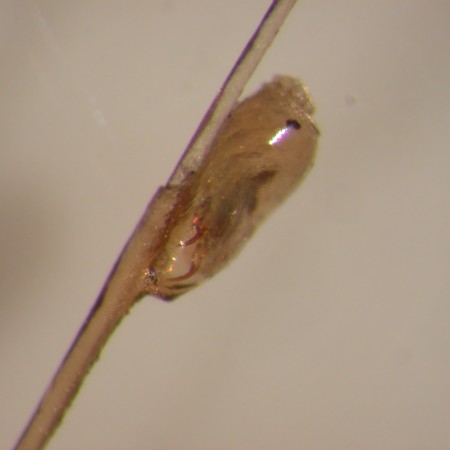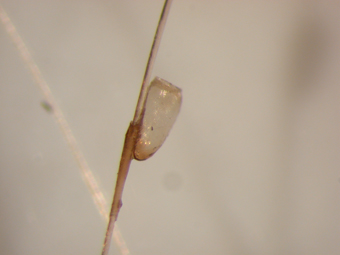LICE EGGS, LOUSE EGG (NITS)
How many eggs can a Louse lay?
In general, the females begin to oviposit 24 hours from the final cast of skin. She lays only one egg at a time, because each egg fills 20 per cent her abdomen. Yet she lays an average of 5 eggs per day.
The actual oviposition is relatively quick. At first, the female head louse finds a suitable place on the hair by the scalp, where she secretes a drop, which glues the egg to the hair. Then she lays the egg in the drop of secrete, while simultaneously moving forward in order not to glue to the hair herself.
The eggs are mainly laid on the hair behind a line from the tip of the ears to the top of the crown. Usually, the eggs are deposited close to the scalp, where there is sufficient warmth and humidity for an optimal development.
It is not known precisely how many eggs a female louse can lay in a day, but if an adult female head louse lives approximately 20 days, she can lay a maximum of 100 eggs during her life time. However, some of the eggs will not be fertilized and other eggs never hatch.
The newly laid egg may look coloured, but in fact, it is colourless and transparent. The egg seems coloured because the surface of the egg acts like a lens, reflecting the colour of the surrounding hair. As a result, the eggs become more difficult to spot. Contrary, hatched eggs appear whitish and are easy to see with the naked eye.
How to Identify and Detect Lice Eggs (Nits)
Detecting lice eggs (nits) can be challenging due to their small size and the fact that they blend in with the hair. Lice eggs are firmly glued to individual hair strands, making them hard to remove by simply washing or shaking the hair. To successfully identify nits, it’s important to understand where and how they are attached to the hair.
Nits are often laid close to the scalp, as this area provides the ideal environment for egg development. The warmth and moisture near the scalp help ensure the eggs mature properly. Typically, they are found behind the ears, at the nape of the neck, or on the crown of the head.
Using a magnifying glass or a lice comb under bright light can make it easier to spot these eggs. Remember, newly laid eggs may look slightly darker or match the color of the surrounding hair, while hatched eggs will appear white or transparent and are easier to spot with the naked eye. Carefully combing through the hair and checking both live and hatched eggs regularly is an essential part of lice management.
The Lifecycle of Lice Eggs
The development of a louse egg goes through several stages. After being laid by the female, it typically takes around 7 to 10 days for the egg to hatch, depending on environmental conditions like temperature and humidity. After hatching, the young louse (also called a nymph) will emerge, leaving the empty shell, or nit, behind.
The empty nit remains attached to the hair until it is either manually removed or naturally falls off as the hair grows. This can make it easy to mistake hatched nits for active lice infestations, so it’s important to differentiate between live eggs and empty shells.

Egg with live louse nymph just before hatching – the black eye spot of the louse can be discerned inside the egg

Empty hatched egg
